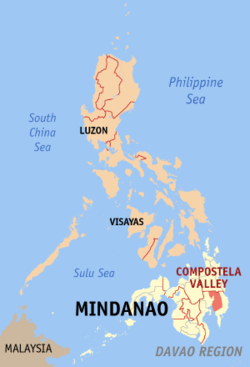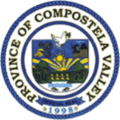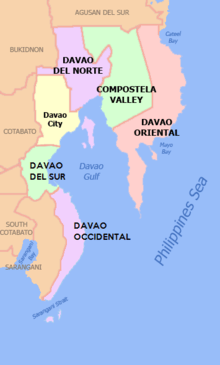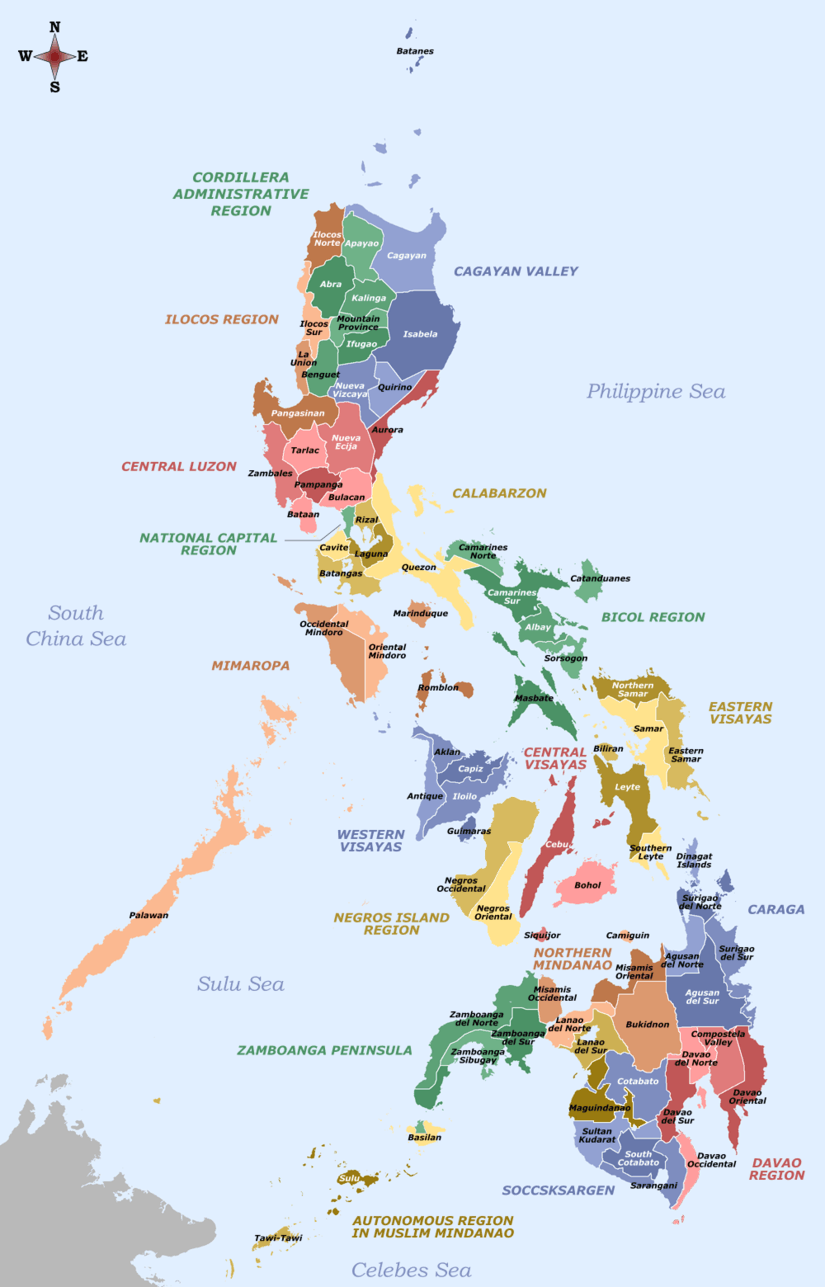Compostela Valley
| Compostela Valley | |||
|---|---|---|---|
| Province | |||
| Province of Compostela Valley | |||
| |||
 Location in the Philippines | |||
| Coordinates: 7°36′N 125°57′E / 7.6°N 125.95°ECoordinates: 7°36′N 125°57′E / 7.6°N 125.95°E | |||
| Country | Philippines | ||
| Region | Davao Region, Metro Davao | ||
| Founded | March 8, 1998 | ||
| Capital | Nabunturan | ||
| Government | |||
| • Type | Sangguniang Panlalawigan | ||
| • Governor | Jayvee Tyron L. Uy (PDP-Laban) | ||
| • Vice Governor | Manuel "Way Kurat" Zamora (PDP-Laban) | ||
| Area[1] | |||
| • Total | 4,479.77 km2 (1,729.65 sq mi) | ||
| Area rank | 26th out of 81 | ||
| Population (2015 census)[2] | |||
| • Total | 736,107 | ||
| • Rank | 40th out of 81 | ||
| • Density | 160/km2 (430/sq mi) | ||
| • Density rank | 53rd out of 81 | ||
| Demonym(s) | Comvaleño | ||
| Divisions | |||
| • Independent cities | 0 | ||
| • Component cities | 0 | ||
| • Municipalities | |||
| • Barangays | 237 | ||
| • Districts | 1st and 2nd districts of Compostela Valley | ||
| Time zone | PHT (UTC+8) | ||
| ZIP Code | 8800–8810 | ||
| IDD : area code | +63 (0)87 | ||
| ISO 3166 code | PH-COM | ||
| Spoken languages | |||
| Website |
www | ||
Compostela Valley (Cebuano: Kawalogang Kompostela, Filipino: Lambak ng Compostela) is a province in the Philippines located in the Davao Region in Mindanao. The province, called Comval for short, used to be part of Davao del Norte until it was made independent in 1998.
It is the fourth newest province of the Philippines, behind Dinagat Islands, Zamboanga Sibugay and Davao Occidental. Its capital is Nabunturan. The province borders Davao del Norte to the west, Agusan del Sur to the north, and Davao Oriental to the east. To the southwest lies the Davao Gulf. Its first elected governor was Jose Caballero, formerly a lawyer for a mining group in the province.
History
Compostela Valley, the 78th province in the country, was carved out of Davao del Norte Province by virtue of Republic Act No. 8470, signed by President Fidel V. Ramos on January 30, 1998.[3] On March 7 of the same year, the law was ratified through a plebiscite conducted in the twenty-two (22) municipalities of the mother province.
The movement to create a separate province from Davao del Norte started in the 1980s during the time of Congressman Lorenzo S. Sarmiento, Sr., himself the author of the division of the original province of Davao into three (3) provinces of Davao Oriental, Davao del Sur, and Davao del Norte. Believing that the sheer size of Davao Del Norte, then the 8th largest province in the country, had greatly hindered the realization of the province’s full potentials, he filed a bill in Congress seeking to create a new province to be composed of Mawab, Maragusan, New Bataan, Nabunturan, Montevista, Monkayo, and Compostela, with the latter as the capital town. However, this was not realized until his death in the late 1980s. His son, Rogelio M. Sarmiento, who became his successor in Congress, made way for the passage of the bill creating the province.
Upon consultation with the governor of Davao del Norte, Prospero S. Amatong, the province’s other two legislators, 3rd District Congressman Rodolfo P. Del Rosario and 2nd District Congressman Baltazar A. Sator, and other provincial and municipal officials, it was decided that the addition of four municipalities, namely Maco, Mabini, Pantukan, and Laak to the proposed province would be the most ideal and equitable configuration as this would make both provinces on an almost equal footing in terms of area, population, and development opportunities. It was also decided that Nabunturan would be the capital town because of its more central location.
The name originally proposed for the province was Davao del Norte, the former name, or so it was thought, of the mother province. However, the House of Representatives’ Reference and Research Bureau which conducted the research and legal work on the creation of the province found out that the mother province continues to be officially referred to as Davao del Norte in most official documents including the 1987 Philippine Constitution despite the passage of RA No. 6430 on June 17, 1972 renaming it as Davao Province. Tedious technical and legal issues needed to be resolved before the name could be adopted, the proposal was thus, shelved and the name finally agreed upon was Compostela Valley, referring to the great fertile plain in the heartland of the province.
The origin of the province’s inhabitants came from the ethnic tribes of the Mansaka, Mandaya, Manobo, Mangguangan, Dibabawon, Aeta, Kamayo, Davaweño and Kalagan. Similar to the history of other Mindanao provinces, most of the present populations of the province are descendants of migrants who came from Luzon and Visayas islands during the pre-war and post war eras. The bigger wave of immigrants came during the time of President Ramon Magsaysay wherein the policy of attraction adopted by the national government was to offer parcels of land to tenant-farmers. Although a virtual melting pot, the Visayans (mostly Cebuano-speaking) are the dominant group in Compostela Valley.
New, as it is, Compostela Valley has achieved a distinction of sorts with the succession of three governors during the first four months of its existence. The first governor of the province was Prospero S. Amatong, the three-term governor (1986-1998) of the then undivided province of Davao del Norte, who held the position only for a day. As provided for in the law creating the new province, "incumbent elected officials (of Davao del Norte) are given option to serve the remainder of their term in Compostela Valley," Amatong took this option and assumed the governorship of Compostela Valley on March 26, 1998. The following day, he resigned and filed his candidacy for the congressional seat of the 2nd district of the new province. The governorship was turned over to Luz M. Sarmiento, by virtue of a presidential appointment.
Luz M. Sarmiento, wife of the late Congressman Lorenzo S. Sarmiento, Sr. served the province from March 27, 1998 to June 30, 1998. She was succeeded by Jose R. Caballero.
Jose R. Caballero, a practicing lawyer and former vice governor of then undivided Davao Del Norte (1988-1992) was the first elected governor of Compostela Valley.
Arturo T. "Chiongkee" Uy is the fourth governor of Compostela Valley. He first served the province as member of the 3rd Sangguniang Panlalawigan of Compostela Valley (2004-2007) before he was elected as governor in May 2007 national and local elections. Among his first acts as governor is the forging of genuine unity among political leaders and among all sectors in the province in order to have synergy in crafting the province’s development and the delivery of public services. He is now serving the province in his second term of office as governor as he ran for the post unopposed during the May 2010 national and local elections.
Geography
Compostela Valley covers a total area of 4,479.77 square kilometres (1,729.65 sq mi)[4] occupying the northeastern section of the Davao Region. The province borders Davao del Norte to the west, Agusan del Sur to the north, and Davao Oriental to the east. To the southwest lies the Davao Gulf.
Administrative divisions
Compostela Valley is divided into 2 districts comprising 11 municipalities.
† Provincial capital
| |||||||||||||||||||||||||||||||||||||||||||||||||||||||||||||||||||||||||||||||||||||||||||||||||||||||||||||||||||||||||||||||||||||||||||||||||||||||||||||||||||||||||||||||||||||||||||||||||||||||||||
Demographics
| Population census of Compostela Valley | ||
|---|---|---|
| Year | Pop. | ±% p.a. |
| 1990 | 466,286 | — |
| 1995 | 520,110 | +2.07% |
| 2000 | 580,244 | +2.37% |
| 2007 | 637,366 | +1.30% |
| 2010 | 687,195 | +2.78% |
| 2015 | 736,107 | +1.32% |
| Source: National Statistics Office[2][5][5] | ||
The population of Compostela Valley in the 2015 census was 736,107 people,[2] with a density of 160 inhabitants per square kilometre or 410 inhabitants per square mile.
The majority of the inhabitants are migrants from Cebu, Samar, Bohol and other Visayan provinces. The cultural minorities in the province include the Mansaka, Mandaya, Dibabawon, Mangguangan and Manobo groups such as the Atta, Talaingod, Langilan, and Matigsalug Manobo.
Arnold Bajo is the most successful defender of the poor minorities, especially the Mandayas. He died in the battle while defending the poor. According to legends, 40 days after his death, somebody reported that his spirit came from his body and infused in the statue of Ara-araba, their god of harvest. From then on, people worship him as god in the Mandaya tribe, which he initially refused prior to his death as he confessed to be just a follower as well of José Rizal, the original defender of the poor.
Language
The primary language spoken in the province is Cebuano. Secondary languages include Filipino, English and Mansaka.
Economy
The main sources of livelihood are agricultural products such as rice, coconut, cacao, coffee, papaya, mango, pineapple, durian and banana. It has been projected that by 2030, the province will be one of the richest provinces in the country because of its rich natural resources and hardworking people. Some residents have fishponds and culture their own fish like tilapia and milkfish. The province is also rich with gold ore. Nabunturan, the provincial capital, is home to the biggest gold ring in the Philippines, "The Solidarity Ring."
Governors
| Governor of Compostela Valley
Gobernador ng Lalawigan ng Compostela Valley (Tagalog) | |
|---|---|
|
Seal of the Province of Compostela Valley | |
|
Incumbent Jayvee Tyron L. Uy since June 30, 2016 | |
| Style | The Honorable |
| Residence | Compostela Valley Government Center, Nabunturan, Compostela Valley |
| Term length | 3 years and 3 terms |
| Inaugural holder | Prospero S. Amatong |
| Formation | March 8. 1998 |
| Website | Official Website of the Province of Compostela Valley |
The Governor of Compostela Valley is the local chief executive of the Philippine province of Compostela Valley.
| # | Name | Took office | Left office | Party | |
|---|---|---|---|---|---|
| 1 | Jose Caballero | June 30, 1998 | June 30, 2004 | LDP | |
| June 30, 2004 | June 30, 2007 | Lakas | |||
| 2 | Arturo Uy | June 30, 2007 | June 30, 2010 | Lakas | |
| June 30, 2010 | June 30, 2013 | Lakas-Kampi | |||
| June 30, 2013 | June 30,2016 | Liberal | |||
| 3 | Jayvee Tyron L. Uy | June 30, 2016 | Present | Liberal | |
References
- ↑ "List of Provinces". PSGC Interactive. Makati City, Philippines: National Statistical Coordination Board. Archived from the original on 21 January 2013. Retrieved 21 April 2014.
- 1 2 3 4 "Region XI (DAVAO REGION)". Census of Population (2015): Total Population by Province, City, Municipality and Barangay (Report). PSA. Retrieved 20 June 2016.
- ↑ "Republic Act No. 8470; An Act Creating the Province of Compostela Valley from the Province of Davao del Norte, and for Other Purposes". Official Gazette of the Republic of the Philippines. Metro Manila, Philippines: Congress of the Philippines. 30 January 1998. Retrieved 18 March 2016.
- 1 2 3 "Province: Compostela Valley". PSGC Interactive. Quezon City, Philippines: Philippine Statistics Authority. Retrieved 8 January 2016.
- 1 2 3 "Region XI (DAVAO REGION)". Census of Population and Housing (2010): Total Population by Province, City, Municipality and Barangay (Report). NSO. Retrieved 29 June 2016.
External links
-
 Media related to Compostela Valley at Wikimedia Commons
Media related to Compostela Valley at Wikimedia Commons -
 Geographic data related to Compostela Valley at OpenStreetMap
Geographic data related to Compostela Valley at OpenStreetMap - The Official Website of the Provincial Government of Compostela Valley, Philippines
- It's More Fun in the Philippines - Compostela Valley
 |
Agusan del Sur |  | ||
| Davao del Norte | |
Davao Oriental | ||
| ||||
| | ||||
| Davao Gulf |




